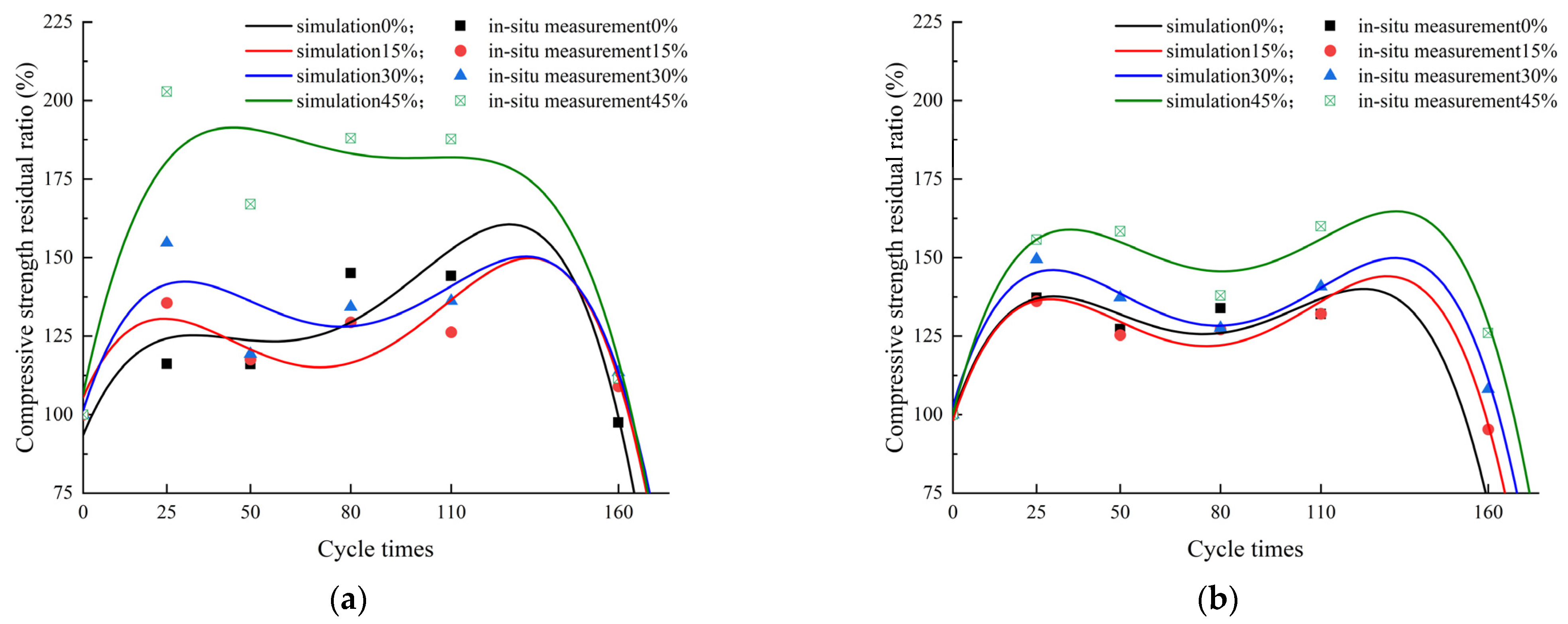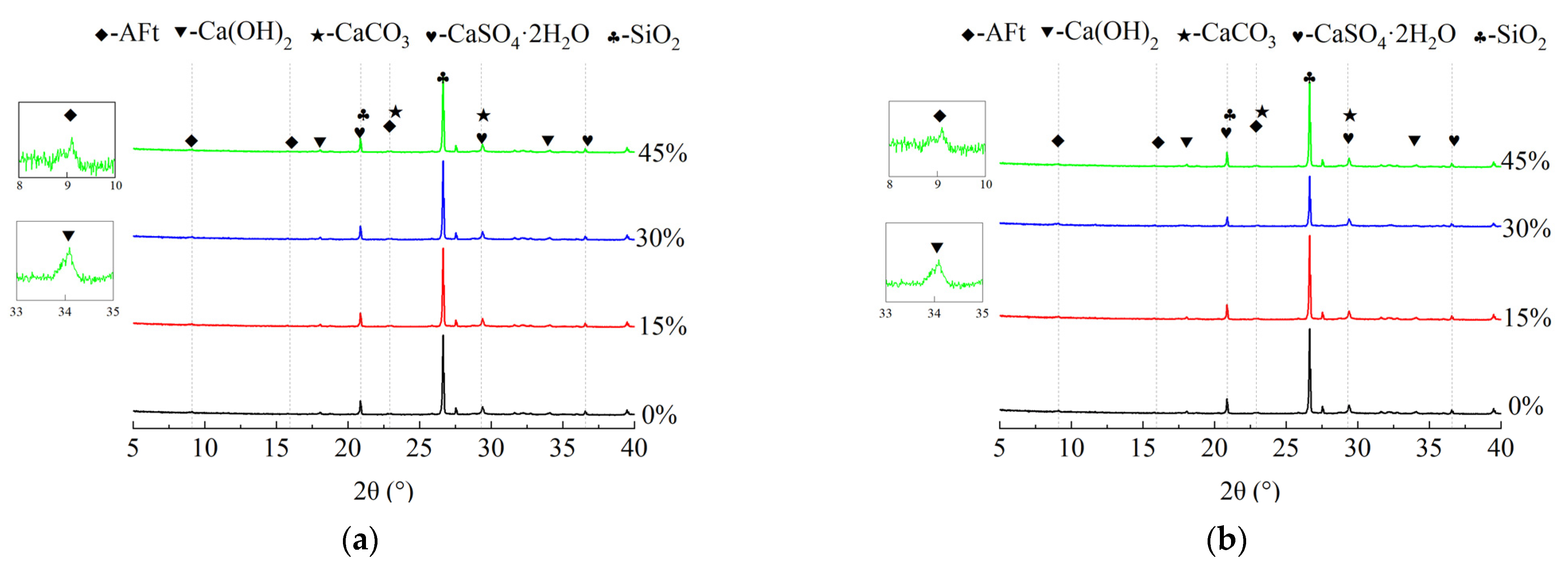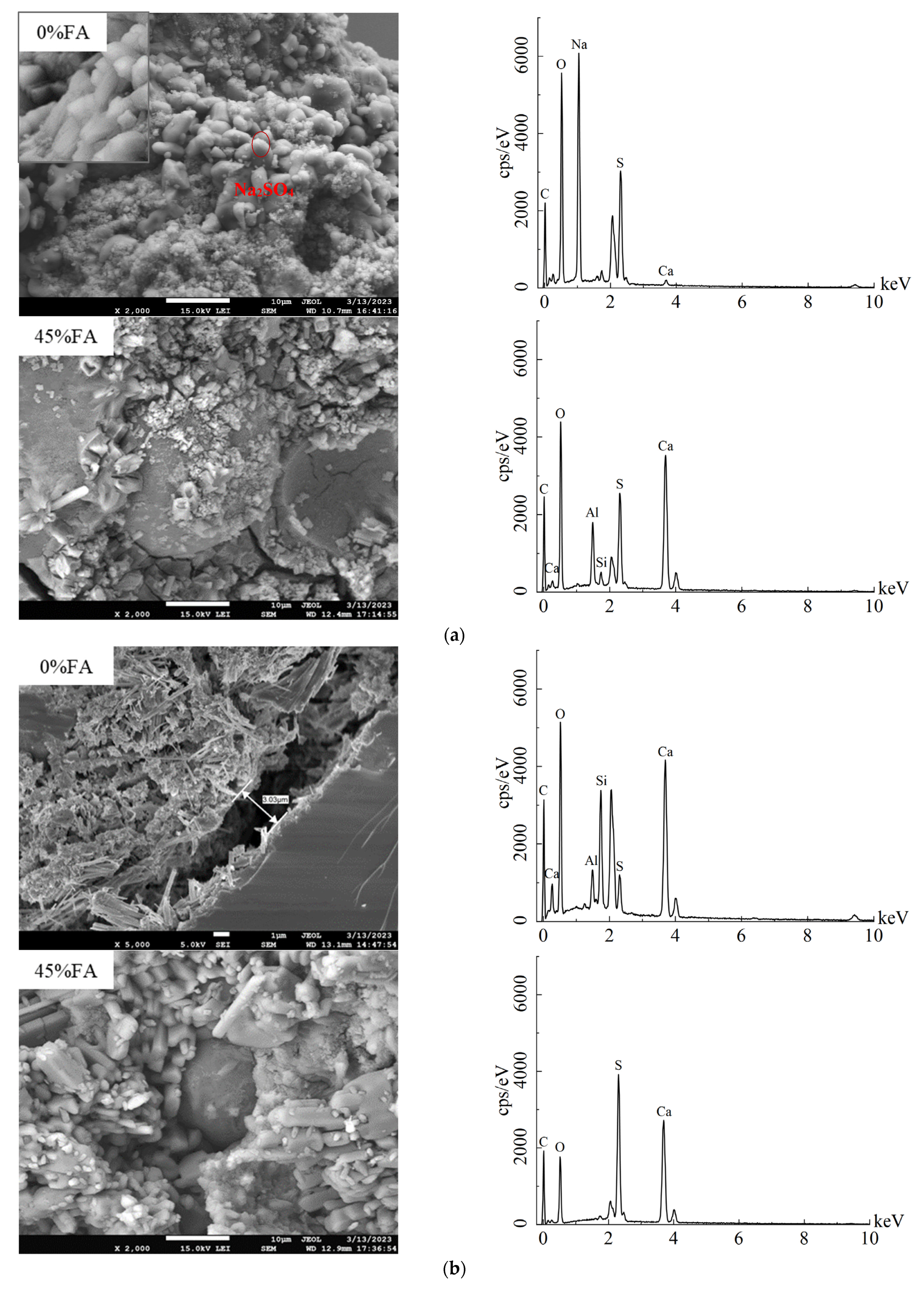Influence of Fly Ash Content on the Durability of Mortar Specimens under Dry/Wet Sulfate Attack
Abstract
:1. Introduction
2. Experimental Design
2.1. Material Properties
2.2. Material Mixes and Maintenance Systems
2.3. Test Method
2.4. Testing Instruments
3. Test Results and Analysis
3.1. Appearance Changes
3.2. Mechanical Properties
3.2.1. Flexural Strength
3.2.2. Compressive Strength
3.2.3. Compressive Strength Evolution Model
- (1)
- Model building
- (2)
- Model evaluation
3.3. Microanalysis
3.3.1. XRD
3.3.2. SEM
4. Discussion
- This study investigated the durability of steam-cured high-volume fly ash cementitious materials under dry–wet sulfate attack conditions with a sulfate ion concentration of 20,250 mg/L. Further extensions of the dry–wet sulfate attack investigations at different sulfate ion concentrations should be considered.
- The present study focused solely on the influence of two factors, namely, the fly ash content and the curing regimes, on the basic mechanical properties and durability of the fly ash cement mortar specimens. Other factors, such as the constant temperature duration and dwell time, have not been explored and could be addressed in subsequent research.
5. Conclusions
- The minimum correlation coefficient between the mathematical simulation of the relative compressive strength and the actual experimental results was 0.879, indicating that the model is reliable. Predictive modeling was employed to assess the specimens with a relative compressive strength of 75%. It was observed that the specimens with the 15% fly ash content under the standard-curing conditions and the specimens with the 45% fly ash content under the steam-curing conditions exhibited favorable resistance to the sulfuric acid attack.
- The pure cement mortar specimens exhibited a single stage of compressive strength growth, while the mortar specimens with the fly ash content exhibited two stages of compressive strength growth. This phenomenon was attributed to the continued hydration of the fly ash during the erosion phase, resulting in an increase in the compressive strength. Simultaneously, the incorporation of the fly ash proved effective in mitigating the late-stage strength degradation of the cementitious matrix induced by steam curing.
- Under standard-curing conditions, with the increase in the fly ash content, the main sulfate erosion products gradually changed from sodium sulfate to ettringite and gypsum. However, under the steam-cured condition at 70 °C, the increase in the fly ash content led to a change in the main sulfate erosion products from gypsum and ettringite to mainly gypsum.
Author Contributions
Funding
Institutional Review Board Statement
Informed Consent Statement
Data Availability Statement
Conflicts of Interest
References
- Zhao, J.; Tan, Y.; Li, H.; Xie, Y.; Yi, Z. Influence of steam-curing on the permeability of track slab concrete of highspeed railway. J. Railw. Sci. Eng. 2012, 9, 8–12. (In Chinese) [Google Scholar]
- Li, X.; Zhu, E.; Zhou, Y.; Qin, Y. Research on the Key Technology in Steam Curing for 32 m Simple-Supported Box Girder of High-Speed Railway. Appl. Mech. Mater. 2011, 90, 958–963. [Google Scholar]
- Ma, K.; Long, G.; Xie, Y. A real case of steam-cured concrete track slab premature deterioration due to ASR and DEF. Case Stud. Constr. Mater. 2017, 6, 63–71. [Google Scholar] [CrossRef]
- Zou, C.; Long, G.; Zeng, X.; Ma, K.; Xie, Y. Hydration and multiscale pore structure characterization of steam-cured cement paste investigated by X-ray CT. Constr. Build. Mater. 2021, 282, 122629. [Google Scholar] [CrossRef]
- Niu, Q.; Feng, N.; Zhang, M.; Zheng, L. Durability Issues of Concrete Road and Bridge Materials in Saline-Alkali Environments. China Cem. 2004, 1, 50–52. (In Chinese) [Google Scholar]
- Editorial Department of China Journal of High way and Transport. Review on China’s Subgrade Engineering Research·2021. China J. Highw. Transp. 2021, 34, 1–49. (In Chinese) [Google Scholar]
- Wang, J.; Li, J.; Zhao, S.; He, Y.; Yan, X.; Wu, P. Research Progress and Prospect of Resource Utilization of Fly Ash in China. Bull. Chin. Ceram. Soc. 2018, 37, 3833–3841. (In Chinese) [Google Scholar]
- Sun, D.; Wang, H.; Liu, K.; Wang, A.; Li, P.; Zhang, G.; Guan, Y. Effect of Fly Ash on Performance of Mortars Partially Exposed to Sulfate Solution Under Low Humidity. Mater. Rep. 2020, 34, 14079–14086. (In Chinese) [Google Scholar]
- Liu, Z.; Li, X.; Hou, L.; Shi, B.; Deng, D. Accelerating Effect of Fly Ash on Damage of Concrete Partially Immersed to Sulfate Environment. J. Build. Mater. 2017, 20, 439–443+448. (In Chinese) [Google Scholar]
- Arel, H.Ş.; Shaikh, F.U.A. Effects of fly ash fineness, nano silica, and curing types on mechanical and durability properties of fly ash mortars. Struct. Concr. 2018, 19, 597–607. [Google Scholar] [CrossRef]
- Wei, Y.; Chai, J.; Qin, Y.; Li, Y.; Xu, Z.; Li, Y.; Ma, Y. Effect of fly ash on mechanical properties and microstructure of cellulose fiber-reinforced concrete under sulfate dry–wet cycle attack. Constr. Build. Mater. 2021, 302, 124207. [Google Scholar] [CrossRef]
- Wang, X.; Yuan, J.; Wei, P.; Zhu, M. Effects of fly ash microspheres on sulfate erosion resistance and chlorion penetration resistance in concrete. J. Therm. Anal. Calorim. 2020, 139, 3395–3403. [Google Scholar] [CrossRef]
- Ba, M.; Qian, C.; Guo, X.; Han, X. Effects of steam curing on strength and porous structure of concrete with low water/binder ratio. Constr. Build. Mater. 2011, 25, 123–128. [Google Scholar] [CrossRef]
- Liu, B. Study on Efficiency of Fly Ashand Its Application in Steam-Curing Concrete. Ph.D. Thesis, Central South University, Changsha, China, 2007. [Google Scholar]
- Wu, K. Study on the Anti-Carbonation Properties of Autoclaved Fly-Ash Content. Master’s Thesis, Central South University, Changsha, China, 2009. [Google Scholar]
- Xiong, R.; Long, G.; Xie, Y.; Wang, M. Influence of Mineral Admixtures on Compressive Strength and Pore Structure of Steam-Cured High-Strength Cement Paste. J. Chin. Ceram. Soc. 2017, 45, 175–181. (In Chinese) [Google Scholar]
- El-Wafa, M.A.; Fukuzawa, K. Optimization of Alkali-Activated Municipal Slag Composite Performance by Substituting Varying Ratios of Fly Ash for Fine Aggregate. Materials 2021, 14, 6299. [Google Scholar] [CrossRef] [PubMed]
- Choi, H.-B.; Park, J.-O. Study on Mechanical Properties of Concrete Using Basalt-Based Recycled Aggregate and Varying Curing Conditions. Materials 2022, 15, 4563. [Google Scholar] [CrossRef] [PubMed]
- Zhou, Y.; Zhan, Y.; Zhu, M.; Wang, S.; Liu, J.; Ning, N. A Review of the Effects of Raw Material Compositions and Steam Curing Regimes on the Performance and Microstructure of Precast Concrete. Materials 2022, 15, 2859. [Google Scholar] [CrossRef]
- Chinese Standard GB/T 17671-2021; Test Method of Cement Mortar Strength (ISO Method). State Market Regulatory Administration: Beijing, China, 2021.
- Liu, L. Constitute and Distributing Character of Salinity in Soil in Xinjiang. Arid. Environ. Monit. 2009, 23, 227–229. (In Chinese) [Google Scholar]
- Chinese Standard GB/T 50082-2009; Standard for Test Methods of Long-Term Performance and Durability of Ordinary Concrete. China Building Industry Press: Beijing, China, 2009.
- Marvila, M.T.; Azevedo, A.R.G.; Monteiro, S.N. Verification of the application potential of the mathematical models of lyse, abrams and molinari in mortars based on cement and lime. J. Mater. Res. Technol. 2020, 9, 7327–7334. [Google Scholar] [CrossRef]
- Guo, Y. Influencing factors of early strength of recycled concrete in sulfate environment. Concrete 2023, 10, 175–179. (In Chinese) [Google Scholar]
- Jiang, G.; Guo, Z.; Li, Y. Study on Optimal Mix Ratio of Filling Slurry. J. Shenyang Agric. Univ. 2022, 53, 483–491. (In Chinese) [Google Scholar]
- Satoh, A.; Yamada, K.; Shinohara, Y. Simulation of Adhesion Performance of Mortar-Mortar Interface with Varied Fractographic Features. In Proceedings of the Advances in Fracture and Damage Mechanics XII, 2014, Sardinia, Italy, 17–19 September 2013; pp. 357–360. [Google Scholar]
- Zhang, Y.; Sun, H.; Li, X.; Hou, X. Study of Steam-Cured System Impact on Concrete Compressive Strength and Prediction of Strength Model. Mater. Rep. 2015, 29, 554–558+564. (In Chinese) [Google Scholar]
- Xu, C.; Liao, H.H.; Chen, Y.L.; Du, X.; Peng, B.; Fernandez-Steeger, T.M. Corrosion Performance of Nano-TiO2-Modified Concrete under a Dry-Wet Sulfate Environment. Materials 2021, 14, 5900. [Google Scholar] [CrossRef] [PubMed]







| Component | CaO | MgO | |||||
|---|---|---|---|---|---|---|---|
| Cement/% | 22.46 | 4.72 | 3.63 | 62.42 | 1.28 | 0.4 | 0.22 |
| Fly ash/% | 54.69 | 20.17 | 6.24 | 8.24 | 2.46 | 1.64 | 1.14 |
| Curing Conditions | SSE/10-2 | MSE/10-3 | RMSE/10-2 | R-Square |
|---|---|---|---|---|
| Standard curing | 25.12 | 10.47 | 10.23 | 0.879 |
| Steam curing | 2.84 | 1.18 | 3.44 | 0.976 |
Disclaimer/Publisher’s Note: The statements, opinions and data contained in all publications are solely those of the individual author(s) and contributor(s) and not of MDPI and/or the editor(s). MDPI and/or the editor(s) disclaim responsibility for any injury to people or property resulting from any ideas, methods, instructions or products referred to in the content. |
© 2023 by the authors. Licensee MDPI, Basel, Switzerland. This article is an open access article distributed under the terms and conditions of the Creative Commons Attribution (CC BY) license (https://creativecommons.org/licenses/by/4.0/).
Share and Cite
Zhang, Y.; Wu, D.; Wang, Y.; Zhou, Y.; Wang, S.; Zhao, Y. Influence of Fly Ash Content on the Durability of Mortar Specimens under Dry/Wet Sulfate Attack. Materials 2024, 17, 113. https://doi.org/10.3390/ma17010113
Zhang Y, Wu D, Wang Y, Zhou Y, Wang S, Zhao Y. Influence of Fly Ash Content on the Durability of Mortar Specimens under Dry/Wet Sulfate Attack. Materials. 2024; 17(1):113. https://doi.org/10.3390/ma17010113
Chicago/Turabian StyleZhang, Yage, Dongge Wu, Yushan Wang, Yang Zhou, Shan Wang, and Yi Zhao. 2024. "Influence of Fly Ash Content on the Durability of Mortar Specimens under Dry/Wet Sulfate Attack" Materials 17, no. 1: 113. https://doi.org/10.3390/ma17010113
APA StyleZhang, Y., Wu, D., Wang, Y., Zhou, Y., Wang, S., & Zhao, Y. (2024). Influence of Fly Ash Content on the Durability of Mortar Specimens under Dry/Wet Sulfate Attack. Materials, 17(1), 113. https://doi.org/10.3390/ma17010113





